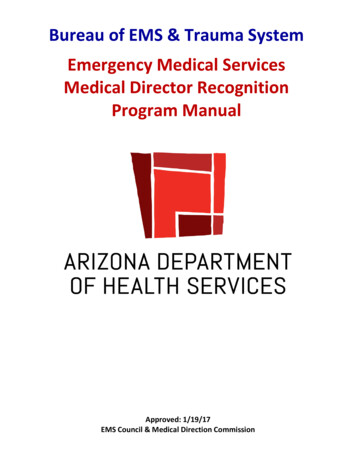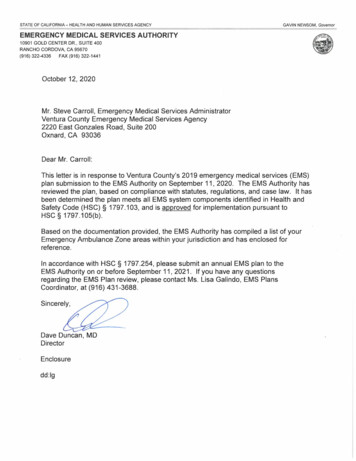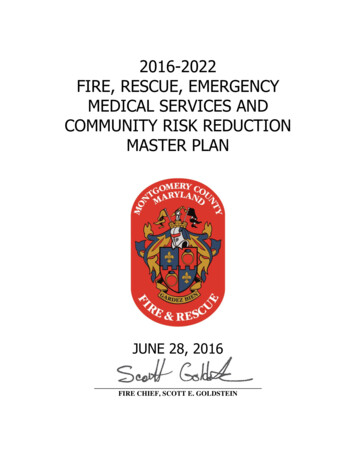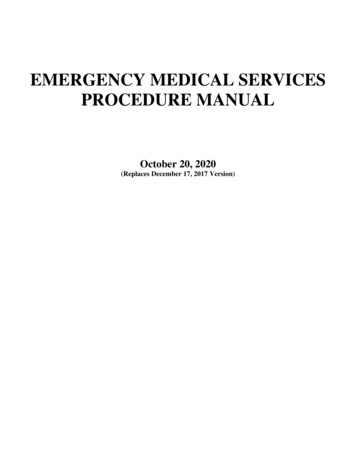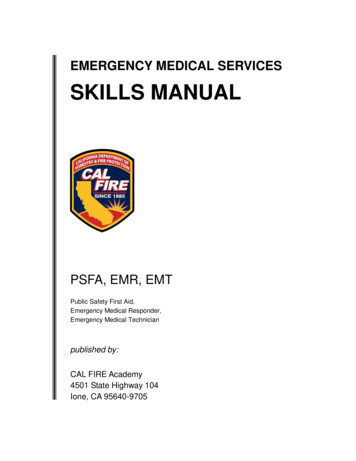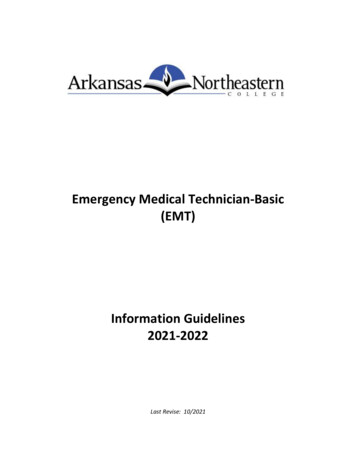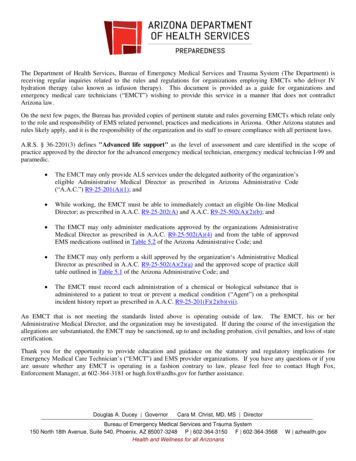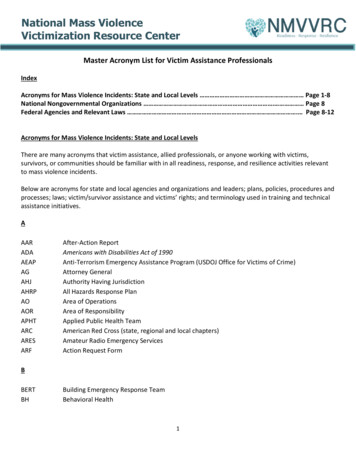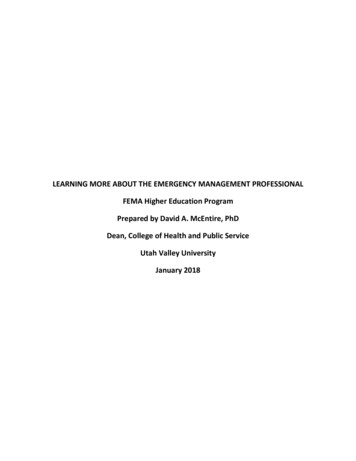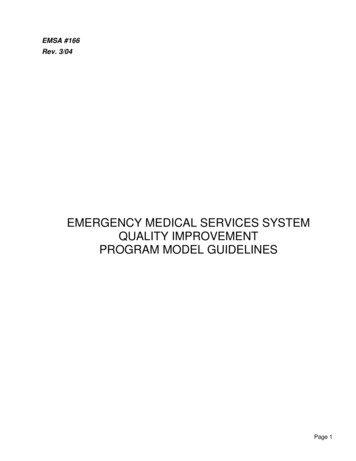
Transcription
EMSA #166Rev. 3/04EMERGENCY MEDICAL SERVICES SYSTEMQUALITY IMPROVEMENTPROGRAM MODEL GUIDELINESPage 1
TABLE OF CONTENTSSECTION I STRUCTURE.5A. State Emergency Medical Services Authority .5B. Local Emergency Medical Services Agency .7C. Base Hospital/Alternate Base Station Providers .8D. Emergency Medical Service Provider .10SECTION II DATA COLLECTION & REPORTING .13A. Data Collection.13B. Approach to Data System Development .13C. Organizational Reporting .14SECTION III EVALUATION OF EMS SYSTEM INDICATORS .15Organization Structure .15Indicators Defined .15Analysis.16Presentation .16Decision-Making Process.16SECTION IV ACTION TO IMPROVE .17Approach to Performance Improvement.17Technical Advisory Group .17Quality Task Force .17Performance Improvement Action .17SECTION V TRAINING AND EDUCATION .18Annual Update Guidelines.19APPENDIX A Self-Assessment and Action Planning . A - 1APPENDIX B 2001 Health Care Criteria for Performance Excellence,Baldridge National Quality Program Core Values and Concepts . B - 1APPENDIX C Organizational Structure . C - 1APPENDIX D Flow of Information and Activity. D - 1APPENDIX E Indicator Categories. E - 1APPENDIX F Development of Standardized EMS Quality Indicators . F - 1APPENDIX G Indicator Detail Sheet .G - 1APPENDIX H Models . H - 1APPENDIX I Plan-Do-Study Act.I - 1APPENDIX J Rapid Cycle Improvement .J - 1APPENDIX K Definitions of Common Data Measurements . K - 1Page 2
APPENDIX L Presentation of EMS System Indicators .L - 1APPENDIX M Quality Improvement Sample Indicators. M - 1Glossary of Terms .245Page 3
EMERGENCY MEDICAL SERVICES SYSTEM QUALITYIMPROVEMENT PROGRAM MODEL GUIDELINES“The ability of EMS to optimally meet communities and individual patients’ needs in the future isdependent on evaluation processes that assess and improve the quality of EMS. Continuousevaluation is essential and should pervade all aspects of every EMS system.”Theodore R. Delbridge MD, MPHPURPOSEThe purpose of these guidelines is to provide a model for the development and implementationof a Quality Improvement Program for the delivery of EMS for EMS service providers, the localEMS agencies (LEMSA), Base Hospitals/Alternate Base Stations, the EMS Authority (EMSA),and their respective personnel. This is a model program, which will develop over time withindividual variances based on available resources.BACKGROUNDGovernmental decision makers, sponsors, and consumers need objective evidence that theyare receiving value and quality for the cost of EMS. The statewide EMS system and itsparticipants require objective feedback about performance that can be used internally tosupport quality improvement efforts and externally to demonstrate accountability to the publicgoverning boards and other stakeholders. The primary goal of each EMS QI Program shall beto ensure continued high quality of patient care.GUIDELINESThe EMS QI Program guidelines were developed to assist EMS professionals in thedevelopment and implementation of a program addressing the following components:9 Organizational structure9 Data collection and reporting9 Evaluation of EMS system indicators9 Methods for improvement9 Training and educationBefore implementing the guidelines, any participant in the EMS system can benefit fromcreating an organization profile and conducting a self-assessment using the Baldrige Criteriafor Performance Excellence (Appendix A).The 2001 Health Care Criteria for Performance Excellence of the Baldrige National QualityProgram should also be reviewed as they provide core values and concepts for an EMS QIProgram (Appendix B).Page 4
SECTION ISTRUCTUREOrganizational StructureThe EMS organizational structure is defined by statute and regulation. There are four distinctlevels identified (Appendix C):9 The State Emergency Medical Services Authority (EMSA)9 Local Emergency Medical Services Agencies (LEMSAs)9 Base Hospitals/Alternate Base Stations9 EMS Service ProvidersOrganizations at these four levels have demonstrated an effective network capable ofproviding patient care in the prehospital setting through the implementation and managementof existing programs. Levels should be mutually dependent on each other for an EMS QIProgram to be successful. While each level has defined roles and responsibilities in achievingits program goals, there is also a shared responsibility with all other levels in achieving EMSsystem goals. The four organizational levels are described as follows:A. State Emergency Medical Services AuthorityResponsible AgencyEmergency Medical Services AuthorityThe Health and Safety Code Division 2.5 states:1797.103. The EMSA shall develop planning and implementation guidelines for emergencymedical services systems which address the following components:(a) Manpower and training(b) Communications(c) Transportation(d) Assessment of hospitals and critical care centers(e) System organization and management(f) Data collection and evaluation(g) Public information and education(h) Disaster response1797.174. In consultation with the commission, the Emergency Medical Directors Associationof California, and other affected constituencies, the EMSA shall develop statewide guidelinesfor continuing education courses and approval for continuing education courses for EMT-Psand for quality improvement systems which monitor and promote improvement in the quality ofcare provided by EMT-Ps throughout the state.StructureThe State EMS QI Program should consist of a team within the EMSA. The team’sorganizational chart should reflect the integration of the EMS QI Program into the EMSA.There should be:1. An EMS QI Team, under the direction of the EMSA Director. Members of the State EMS QITeam should have expertise in administration and management of state/local EMS systemsand local EMS QI Programs, especially in the following areas: EMS Evaluation and Quality Improvement Data SystemsPage 5
BiostatisticsClinical Aspects of EMS2. A Technical Advisory Group with statewide representation to include but not be limited to: LEMSA Administrator(s) or designee LEMSA Medical Director(s) EMS Service Provider Medical Director(s) EMS Educator(s) EMS Receiving Facilities EMS Personnel EMS Service Provider EMS QI Program Representative(s) Public Representative(s)3. The Technical Advisory Group will seek and maintain relationships with all EMS participantsincluding but not limited to: Local EMS Agencies EMS Service Provider(s) EMS Receiving Facilities Base Hospital(s) EMS Dispatch Center(s) Labor and Management Local Department of Health Law Enforcement Primary System Answering Point(s) (PSAP(s)) Constituent Group(s) Specialty Center(s) Poison Control Public Organization(s)ResponsibilitiesThe State EMS QI Team will be the central repository of statewide EMS system information asit relates to EMS QI Program activities. Under the direction of the EMSA Director and advicefrom the State EMS QI Program Technical Advisory Group, the State EMS QI Team willperform the following functions (Appendix D): Carry out the responsibilities of the statewide EMS QI Program Coordinate the development, approval, and implementation of state required EMSsystem indicators Coordinate the development, approval, and implementation of state optional EMSsystem indicators Monitor, collect data on and evaluate data on state required and optional EMS systemindicators Provide a recommended format for reporting required and optional EMS systemindicators Organize, analyze, and report feedback to participating agencies using state EMSsystem indicators Re-evaluate, expand upon and improve state EMS system indicators annually or asneeded Facilitate meetings and presentations on state EMS system indicators with designatedadvisory groups and other stakeholders for the purpose of system and patient careimprovementPage 6
Establish a mechanism to incorporate input from the local EMS agencies, providers andother EMS system participants for the development of performance improvement plansAssure reasonable availability of EMS QI Program training and in-service education forEMS personnel under the statewide EMS QI ProgramPrepare plans for improving the State EMS QI ProgramProvide technical assistance for facilitating the LEMSAs’ EMS QI ProgramProtect confidentiality/integrity of data (patient and personnel)Regularly review and revise the EMS QI Program Model Guidelines as needed with EMSconstituent inputAnnual ReportsThe State EMS QI Team will annually publish summary reports of activity and planimplementation with national and local distribution.B. Local Emergency Medical Services AgencyResponsible AgencyLocal Emergency Medical Services AgencyThe Health and Safety Code Division 2.5 states:1797.204 The local EMS agency shall plan, implement, and evaluate an emergency medicalservices system, in accordance with the provisions of this part, consisting of an organizedpattern of readiness and response services based on public and private agreements andoperational procedures.StructureThe LEMSA EMS QI Team should be reflected on the LEMSA organization chart. Thereshould be:1. An EMS QI team under the direction of the LEMSA administration. The team should haveeducation and experience in evaluation of EMS data system, and EMS QI Programmanagement.Note: Availability of resources can vary greatly between urban and rural agencies. It isunderstood that there are variances in staffing and staff responsibilities.2. The Technical Advisory Group should be multidisciplinary and may include, but not belimited to: LEMSA Medical Director LEMSA Representative EMS Service Provider Medical Director(s) EMS Provider EMS QI Program Coordinator(s) EMS Educator(s) Base Hospital Representative(s) Representative(s) from local receiving facilities emergency department physicians Representatives from Basic Life Support (BLS) and Advanced Life Support (ALS)certified/licensed personnel accredited within the LEMSA Public representative(s)3) The Technical Advisory Group will seek and maintain relationships with all EMS participantsincluding but not limited to: State EMSA Other LEMSAsPage 7
EMS Service Provider(s)Local Department of HealthSpecialty Care Center(s)Law EnforcementPSAP(s)EMS Dispatch Center(s)Constituent GroupsResponsibilitiesThe LEMSA EMS QI Team should be the central repository of local or regional EMS systeminformation as it relates to EMS QI Program activities. The team should perform the followingfunctions: Cooperate with the EMSA in carrying out the responsibilities of statewide EMS QIProgram and participate in the EMSA Technical Advisory Group Cooperate with the EMSA in the development, approval, and implementation of staterequired EMS system indicators Cooperate with the EMSA in the development, approval, and implementation of stateoptional EMS system indicators Maintain responsibility for monitoring, collecting data on, reporting on, and evaluatingstate required and optional EMS System indicators from the EMS providers andhospitals within the jurisdiction of the LEMSA Identify and develop LEMSA specific indicators for system evaluation, based oncomponents listed in Appendix E Maintain responsibility for monitoring, collecting data on, and evaluating locally identifiedindicators Re-evaluate, expand upon, and improve state EMS system indicators and locallydeveloped indicators annually or as needed Facilitate meetings and presentations on LEMSA indicators and the development ofperformance improvement plans for review by designated EMS providers Establish a mechanism to incorporate input from EMS provider advisory groups for thedevelopment of performance improvement plans Assure reasonable availability of EMS QI Program training and in-service education forEMS personnel under the statewide EMS QI Program Prepare plans for improving the LEMSAs’ EMS QI Program Provide technical assistance for facilitating the EMS QI Programs of all organizationsparticipating in the LEMSA EMS QI ProgramAnnual ReportsThe LEMSA EMS QI Team will annually publish a summary of activity and plan implementationfor distribution.C. Base Hospital/Alternate Base StationResponsible AgencyBase Hospital/Alternate Base Station Authority:Health and Safety Code Division 2.5 states:1798.100. In administering the EMS system, the local EMS agency, with the approval of itsmedical director, may designate and contract with hospitals or other entities approved by themedical director of the local EMS agency pursuant to Section 1798.105 to provide medicalPage 8
direction of prehospital emergency medical care personnel, within its area of jurisdiction, aseither base hospitals or alternative base stations, respectively. Hospitals or other entities sodesignated and contracted with as base hospitals or alternative base stations shall providemedical direction of prehospital emergency medical care provided for the area defined by thelocal EMS agency in accordance with policies and procedures established by the local EMSagency and approved by the medical director of the local EMS agency pursuant to Sections1797.220 and 1798.1798.101. (a) In rural areas, as determined by the EMSA, where the use of a base hospitalhaving a basic emergency medical services special permit pursuant to subdivision (c) ofSection 1277 is precluded because of geographic or other extenuating circumstances, a localEMS agency, in order to assure medical direction to prehospital emergency medical carepersonnel, may utilize other hospitals which do not have a basic emergency medical servicepermit but which have been approved by the medical director of the local EMS agency forutilization as a base hospital, if both of the following apply:(1) Medical control is maintained in accordance with policies and procedures established bythe local EMS agency, with the approval of the medical director of the local EMS agency.(2) Approval is secured from the EMSA.The Base Hospital’s EMS QI Program should involve all EMS system participants including butnot limited to dispatch agencies, ALS and BLS EMS service providers, receiving hospitals, andspecialty care centers.StructureThe Base Hospital/Alternate Base Station EMS QI Program should be a program reviewed bythe LEMSA for compatibility with the EMS QI Program guidelines. The organizational chartshould reflect the integration of the EMS QI Program in the organization. There should be:1. An EMS QI Team under the direction of the Base Hospital/Alternate Base Station medicaldirector. Lead staff should have expertise in management of the base hospital’s EMS QIProgram. The following staffing positions are identified (note: organizations with limitedresources may combine positions): Base Hospital/Alternate Base Station Medical Director (or designee) EMS QI Program Coordinator Data SpecialistNote: Availability of resources can vary greatly between urban and rural facilities. It isunderstood that there are variances in staffing and staff responsibilities.2. An internal EMS QI Program Technical Advisory Group with members, which include butare not limited to: Base Hospital Medical Director Prehospital Liaison or Equivalent Base Hospital and EMS Service Provider Personnel (Physicians, RNs, Paramedics,EMTs)Cooperation and interaction with all EMS system participants should include but not belimited to: State EMSA LEMSA Other Base Hospital(s) Receiving Facilities Local Department of Health Law EnforcementPage 9
PSAP(s)Community Group(s)Non-EMS Public Representative(s)EMS Provider(s)ResponsibilitiesThe Base Hospital EMS QI Team should be a primary source of EMS activity reporting forstatewide and local EMS system indicators. The Base Hospital EMS QI Program will performthe following functions: Cooperate with the LEMSA in carrying out the responsibilities of the LEMSA EMS QIProgram and participate in the LEMSA Technical Advisory Group Cooperate with the LEMSA in the implementation of state required EMS systemindicators Cooperate with the LEMSA in the implementation of state optional EMS systemindicators Cooperate with the LEMSA in monitoring, collecting data on, and evaluating staterequired and optional EMS system indicators Cooperate with the LEMSA in monitoring, collecting data on, and evaluatinglocal/regional EMS system indicators Cooperate with the EMSA and LEMSAs in the re-evaluation and improvement of stateand local EMS system indicators Identify and develop base hospital indicators for system evaluation based oncomponents listed in Appendix E Participate in meetings for internal review of base hospital indicators and development ofperformance improvement plans related to the findings Establish a mechanism to incorporate input from the LEMSA, service providers, andother hospitals for the development of performance improvement plans Assure reasonable availability of EMS QI Program training and in-service education forbase hospital personnel Prepare plans for expanding or improving the Base Hospital EMS QI Program Facilitate meetings and presentations of state and local EMS system indicators for peerreview to local designated advisory groups and other authorized constituents Provide technical assistance to all EMS QI Programs in the base hospital’s jurisdictionAnnual UpdatesThe Base Hospital EMS QI Team will annually publish summary reports of EMS QI Programactivity with distribution.D. Emergency Medical Service Provider LevelResponsible AgencyEMS Service ProvidersThe EMS Provider’s EMS QI Program should involve EMS system participants including butnot limited to dispatch agencies, the LEMSA, EMS personnel training programs, hospitals,specialty care centers, and other EMS service providers. A regional approach, withcollaboration between EMS service providers serving neighboring communities, is highlyrecommended.Page 10
StructureThe EMS Provider EMS QI Program should be reviewed by the LEMSA for compatibility withthe EMSA EMS QI Program guidelines.The organizational chart should reflect the integration of the EMS QI Program in theorganization. There should be:1. An EMS QI Team under the direction of the EMS Provider medical director or EMSadministrator. Lead staff should have expertise in management of the EMS provider’s EMS QIProgram. The following staffing positions are identified (organizations with limited resourcesmay combine positions): Provider Medical Director or Designee EMS QI Program Coordinator Data SpecialistNote: Availability of resources can vary greatly between urban and rural agencies. It isunderstood that there are variances in staffing and staff responsibilities.2. An internal EMS QI Program Technical Advisory Group with members which include but arenot limited to: Medical Director (Provider Medical Director or alternatively the LEMSA Medical Director) Chief/Administrator or designee EMS QI Program Coordinator Service Personnel (Physicians, RNs, Paramedics, EMTs) Other system participants3. Cooperation with all EMS participants should include but not limited to: State EMSA LEMSA Other EMS Provider(s) Base and Receiving Facilities Local Department of Health Law Enforcement PSAP(s) Community Group(s) Non-EMS Public representative(s) EMS Dispatch Center(s)ResponsibilitiesThe EMS Provider’s EMS QI Program Technical Advisory Group should be the primary sourceof EMS QI Program activity reporting for statewide and local EMS System information. TheEMS Provider’s EMS QI Program Technical Advisory Group will perform the followingfunctions: Cooperate with the LEMSA in carrying out the responsibilities of the LEMSA’s EMS QIProgram and participate in the LEMSA Technical Advisory Group Cooperate with the LEMSA in the implementation of state required EMS systemindicators Cooperate with the LEMSA in the implementation of state optional EMS systemindicators Cooperate with the local EMS agency in monitoring, collecting data on, and evaluatingstate required and optional EMS system indicators Cooperate with the local EMS agency in monitoring, collecting data on, and evaluatinglocal/regional EMS system indicatorsPage 11
Cooperate in the re-evaluation and improvement of state and local EMS systemindicatorsDevelop, monitor, collect data on, and evaluate indicators specific to the EMS provideras needed (See Appendix E)Conduct meetings for internal review of EMS provider information and development ofperformance improvement plans related to the findingsEstablish a mechanism to receive input from the local EMS agency, other serviceproviders and other EMS system participants for the development of performanceimprovement plansAssure reasonable availability of EMS QI Program training and in-service education forEMS provider personnelPrepare plans for expanding or improving the EMS Provider EMS QI ProgramParticipate in meetings and presentations of state and local EMS system information forpeer review to local designated advisory groups and other authorized constituentsAnnual UpdatesThe EMS Provider EMS QI Team will annually publish summary reports of EMS QI Programactivity for distribution.Page 12
SECTION IIDATA COLLECTION & REPORTINGPurposeTo improve the EMS system, information must first be collected, reported, and evaluated. Thefollowing are guidelines for data collection and reporting of EMS information.A. Data CollectionAspects of care which are identified as important should be monitored despite the possiblecomplexity of necessary data or challenges associated with the data collection. All reliablesources of information should be utilized in the evaluation of system performance. EMSorganizations should also consider the use of hard copy review, collection check-sheets,customer surveys, direct observation, and skills simulation.B. Approach to Data System DevelopmentInformation systems should be designed to answer EMS system performance questions. It isstrongly recommended that EMS organizations establish a practical consensus and clearunderstanding with all users regarding the purpose for collecting and processing the data. Thisstep is vital to assure validity and reliability.The following activities are recommended prior to data systems development:1. Identify the specific mission and purpose of the organization2. Identify the most important services that support the mission and purpose3. Identify the resources, activities, and results that comprise the services4. Identify what information must be reported to others, such as LEMSAs or the stateEMSA5. Identify specific questions (regarding the structures, activities, and outcomes within yourorganization), which need to be answered in order to better understand the success ofthe mission and purpose6. Define how each question will be answered7. Use the answers as the basis for developing indicators8. Develop a quality indicator9. Use the indicators as the basis for identifying what data is needed10. Develop your technical plan for data collection based upon the elements identified11. Test the process prior to investing in a data system12. Recognize that an effective EMS QI Program is dynamic and therefore constantlychanging, and incorporate this need for change into your data vendor contract (ifapplicable) and/or your data management planThe California State EMS data set (with associated definitions) should be incorporated to allowfor statewide data collection. Statewide EMS system indicators provide for comparativeanalysis between similar EMS providers/LEMSAs as well as statewide system evaluation.Additional data elements and code sets should be collected at a local level to focus on regionalissues and concerns. The National EMS Information System (NEMSIS) data set (withassociated definitions) may provide consistent data collection with these additional dataelements.Page 13
Validity and ReliabilityValidity - The data have validity if there is sufficient evidence to warrant the collection and useof the information for the purpose of measuring the performance of the EMS system. Theinformation is valid if it is: Representative of important aspects of service performance Determined to be important for successful service performance Predictive of or significantly correlated with important elements of performanceReliability – The data have reliability if the collection and interpretation methods can be trustedto be consistent and predictable. If the data collection is always performed in the same way,using the same data collection tools and interpreted with the same definitions, the informationis likely to be reliable. Standardized definitions or agreement by the users regarding what thedata will indicate and how they will be collected is critical to the success of the overall program.C. Organizational ReportingData collection, reporting, and analysis shall occur at each of the four organizational levels.Each level shall submit information to their respective advisory group. Data collection andreporting should be done in the form of summary reports and may be based upon core EMSsystem indicators as adopted by the State EMSA, LEMSA, hospital, or individual EMSprovider. Data collected specific to personnel shall only be exchanged between the personneland provider levels. EMS information should be consistent in how it is organized, analyzed,presented and evaluated.See Appendix D for specific diagram showing the flow and exchange of information at alllevels.Page 14
SECTION IIIEVALUATION OF EMS SYSTEM INDICATORSOrganizational StructureIn order to provide a continuous evaluation of EMS services, it is recommended that theorganizations establish technical advisory groups at each level (state, local, hospital, andprovider). Each technical advisory group should be responsible for decision-making regardingevaluation and improvement and should be composed of stakeholders within the system underevaluation.Organization of InformationEMS organizations shall develop indicators which address but are not limited to the following(Appendix E):(1) Personnel(2) Equipment and Supplies(3) Documentation(4) Clinical Care and Patient Outcome(5) Skills Maintenance/Competency(6) Transportation/Facilities(7) Public Education and Prevention(8) Risk ManagementThe recommended approach to organizing data and other sources of information is throughthe development and use of standardized indicators.Indicators DefinedAccording to the Joint Commission on Accreditation of Healthcare Organizations, an indicatoris "a quantitative performance measure a tool that can be used to monitor performance anddirect attention to potential performance issues that may require more intensive review withinan organization.” In other words, an EMS indicator measures the degree of conformance to areasonable expectation as defined by the community served. Indicators may be related tostructures (people, places, things), processes (activities occurring in a system), and outcomes(the results of the structures and activities within a system). In fact, the three types ofindicators (structure, process, and outcome) are all related and dependent upon one another.Hence the following
A. State Emergency Medical Services Authority Responsible Agency . Emergency Medical Services Authority . The Health and Safety Code Division 2.5 states: 1797.103. The EMSA shall develop planning and implementation guidelines for emergency medical services systems which address the following components: (a) Manpower and training (b) Communications
